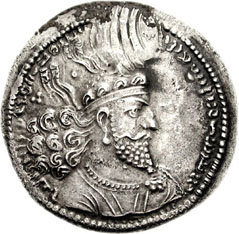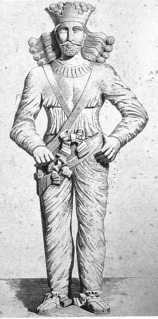Related Research Articles

Hormizd-Ardashir, better known by his dynastic name of Hormizd I, was the third Sasanian King of Kings (shahanshah) of Iran, who ruled from May 270 to June 271. He was the third-born son of Shapur I, under whom he was governor-king of Armenia, and also took part in his father's wars against the Roman Empire. Hormizd I's brief time as ruler of Iran was largely uneventful. He built the city of Hormizd-Ardashir, which still remains a major city today in Iran. He promoted the Zoroastrian priest Kartir to the rank of chief priest (mowbed) and gave the Manichaean prophet Mani permission to continue his preaching.

Hormizd II was king (shah) of the Sasanian Empire. He ruled for seven years and five months, from 303 to 309. He was a son and successor of Narseh.

Hormizd III, was the seventeenth king (shah) of the Sasanian Empire, ruling briefly from 457 to 459. He was the son and successor of Yazdegerd II. His reign was marked by the rebellion of his younger brother Peroz I, who with the aid of one of the Seven Great Houses of Iran, the House of Mihran, and the eastern neighbours of the Sasanians, the Hephthalites, had him captured and executed.

Bahram II was the fifth Sasanian King of Kings (shahanshah) of Iran, from 274 to 293. He was the son and successor of Bahram I. Bahram II, while still in his teens, ascended the throne with the aid of the powerful Zoroastrian priest Kartir, just like his father had done.

Shapur I was the second Sasanian King of Kings of Iran. The dating of his reign is disputed, but it is generally agreed that he ruled from 240 to 270, with his father Ardashir I as co-regent until the death of the latter in 242. During his co-regency, he helped his father with the conquest and destruction of Arab city of Hatra, whose fall was facilitated, according to Islamic tradition, by the actions of his future wife al-Nadirah. Shapur also consolidated and expanded the empire of Ardashir I, waged war against the Roman Empire and seized its cities of Nisibis and Carrhae while he was advancing as far as Roman Syria. Although he was defeated at the Battle of Resaena in 243 by Roman emperor Gordian III, he was the following year able to win the Battle of Misiche and force the new Roman Emperor Philip the Arab to sign a favorable peace treaty that was regarded by the Romans as "a most shameful treaty".

Shapur III, was the Sasanian King of Kings of Iran from 383 to 388. He was the son of Shapur II and succeeded his uncle Ardashir II.
Aspet was a hereditary military title of the Armenian nobility, usually found within the Bagratuni family.

Mirian III was a king of Iberia or Kartli (Georgia), contemporaneous to the Roman emperor Constantine the Great. He was the founder of the royal Chosroid dynasty.

Gugark was the 13th province of the ancient kingdom of Armenia. It now comprises parts of northern Armenia, northeast Turkey, and southwest Georgia.
Artavasdes I was the Artaxiad king of Armenia from 159 BC to 115 BC. He was the son and successor of Artaxias I.
Adarnase II, sometimes known as Adarnase I, was a Georgian Bagratid prince and a co-ruler of Tao-Klarjeti with his brothers — Bagrat I Kuropalates and Guaram Mampali — with the title of eristavt-eristavi.
Adarnase III was a Georgian prince of the Bagratid dynasty of Tao-Klarjeti and hereditary ruler of Tao with the title of eristavt-eristavi, "duke of dukes".

Adarnase I or Adrnerse, of the Chosroid dynasty, was a presiding prince of Iberia from 627 to 637/642.

Adarnase II, of the Chosroid dynasty, was a presiding prince of Iberia from c. 650 to 684/5. He is presumably the Iberian patricius mentioned in the 660s letter of Anastasius Apocrisarius pertaining to the martyrdom of Maximus the Confessor, and the prince Nerses whose revolt against Arabs is reported by the Armenian chronicler Hovannes Draskhanakertsi.

Ganzak, is an ancient town founded in northwestern Iran. The city stood somewhere south of Lake Urmia, and it has been postulated that the Persian nobleman Atropates chose the city as his capital. The exact location, according to Minorsky, Schippmann, and Boyce, is identified as being the ruins at Leylan, Malekan County in the Miandoab plain.
Adarnase was a late 8th-century nobleman of Iberia and the founder of the Georgian Bagratid dynasty. He established himself in Tao-Klarjeti as a vassal of the Chosroid dynasty of Iberia and, as a matter of inheritance, acquired more lands, setting stage for the elevation of the Bagratids—in the person of his son Ashot I—to the principate of Iberia.
Adarnase IV was a member of the Georgian Bagratid dynasty of Tao-Klarjeti and prince of Iberia, responsible for the restoration of the Iberian kingship, which had been in abeyance since it had been abolished by Sasanian Empire in the 6th century, in 888.
Adarnase V, sometimes rendered as Adarnase II or Adarnase IV, was a Georgian prince of the Bagratid dynasty of Tao-Klarjeti and hereditary ruler of Upper Tao with the Byzantine titles of magistros (945) and curopalates (958).
Varsken was an Iranian prince from the Mihranid family of Gugark, who served as the bidaxsh (margrave) of the region from 470 to 482. He was the son and successor of Arshusha II.
The Mihranids of Gugark were an Iranian princely dynasty, which ruled the Armeno-Iberian frontier region of Gugark from c. 330 to the 8th-century. They held the title of bidaxsh ("margrave").
References
- 1 2 3 Sundermann 1989, pp. 242–244.
- ↑ Rapp 2014, p. 62.
- ↑ Rapp 2014, p. 58.
- ↑ Aleksidze 2018.
- 1 2 Toumanoff 1963, p. 163.
- ↑ Toumanoff 1963, p. 155.